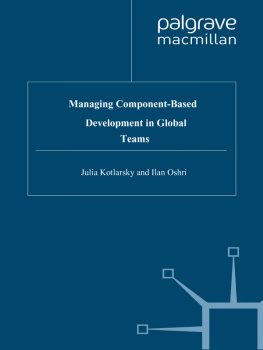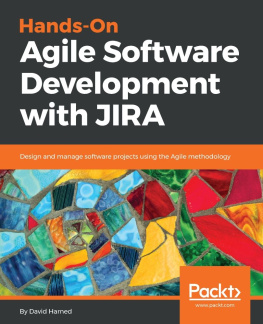Ilan Oshri - Managing Component-Based Development in Global Teams
Here you can read online Ilan Oshri - Managing Component-Based Development in Global Teams full text of the book (entire story) in english for free. Download pdf and epub, get meaning, cover and reviews about this ebook. year: 2009, publisher: Palgrave Macmillan, genre: Business. Description of the work, (preface) as well as reviews are available. Best literature library LitArk.com created for fans of good reading and offers a wide selection of genres:
Romance novel
Science fiction
Adventure
Detective
Science
History
Home and family
Prose
Art
Politics
Computer
Non-fiction
Religion
Business
Children
Humor
Choose a favorite category and find really read worthwhile books. Enjoy immersion in the world of imagination, feel the emotions of the characters or learn something new for yourself, make an fascinating discovery.
- Book:Managing Component-Based Development in Global Teams
- Author:
- Publisher:Palgrave Macmillan
- Genre:
- Year:2009
- Rating:5 / 5
- Favourites:Add to favourites
- Your mark:
- 100
- 1
- 2
- 3
- 4
- 5
Managing Component-Based Development in Global Teams: summary, description and annotation
We offer to read an annotation, description, summary or preface (depends on what the author of the book "Managing Component-Based Development in Global Teams" wrote himself). If you haven't found the necessary information about the book — write in the comments, we will try to find it.
Ilan Oshri: author's other books
Who wrote Managing Component-Based Development in Global Teams? Find out the surname, the name of the author of the book and a list of all author's works by series.
Managing Component-Based Development in Global Teams — read online for free the complete book (whole text) full work
Below is the text of the book, divided by pages. System saving the place of the last page read, allows you to conveniently read the book "Managing Component-Based Development in Global Teams" online for free, without having to search again every time where you left off. Put a bookmark, and you can go to the page where you finished reading at any time.
Font size:
Interval:
Bookmark:
Managing Component-Based Development in Global Teams
Julia Kotlarsky and Ilan Oshri


Julia Kotlarsky and Ilan Oshri 2009
All rights reserved. No reproduction, copy or transmission of this publication may be made without written permission.
No portion of this publication may be reproduced, copied or transmitted save with written permission or in accordance with the provisions of the Copyright, Designs and Patents Act 1988, or under the terms of any licence permitting limited copying issued by the Copyright Licensing Agency, Saffron House, 610 Kirby Street, London EC1N 8TS.
Any person who does any unauthorized act in relation to this publication may be liable to criminal prosecution and civil claims for damages.
The authors have asserted their rights to be identified as the authors of this work in accordance with the Copyright, Designs and Patents Act 1988.
First published 2009 by
PALGRAVE MACMILLAN
Palgrave Macmillan in the UK is an imprint of Macmillan Publishers Limited, registered in England, company number 785998, of Houndmills, Basingstoke, Hampshire RG21 6XS.
Palgrave Macmillan in the US is a division of St Martins Press LLC,
175 Fifth Avenue, New York, NY 10010.
Palgrave Macmillan is the global academic imprint of the above companies and has companies and representatives throughout the world.
Palgrave and Macmillan are registered trademarks in the United States, the United Kingdom, Europe and other countries
ISBN: 978-0-230-22244-1 hardback
This book is printed on paper suitable for recycling and made from fully managed and sustained forest sources. Logging, pulping and manufacturing processes are expected to conform to the environmental regulations of the country of origin.
A catalogue record for this book is available from the British Library.
A catalogue record for this book is available from the Library of Congress.
10 9 8 7 6 5 4 3 2 1
18 17 16 15 14 13 12 11 10 09
Printed and bound in Great Britain by
CPI Antony Rowe, Chippenham and Eastbourne
Figures
Tables
Globally Distributed Component-Based Development (GD CBD) is expected to become a promising area, as increasing numbers of companies are setting up software development in a globally distributed environment and at the same time are adopting Component-Based Development (CBD) methodologies. This process of globalisation and adoption of CBD methodology has introduced potential benefits as well as new challenges in the management of software projects.
On the one hand, it is expected that adoption of CBD will further facilitate globally distributed development of software products, as happened in industries such as aeronautics, automotive, electronics and computers hardware, where Component-Based (CB) architectures have been successfully used for setting up globally distributed design and production. Within the software industry, it is suggested that components could be developed in parallel independently by teams located in the same building or at remote locations. It has been argued that CBD enables each site to take ownership of particular components and work on them independently without much need for inter-site communication and coordination.
On the other hand, research on co-located CBD projects has reported difficulties associated with the management of CBD projects, such as lack of stable standards, lack of reusable components, and problems related to the granularity and generality of components. In the light of these problems, achieving the true potential of CBD, which is mainly about reusing components, is challenging even in co-located CBD projects. Globally distributed organisations may face the above-mentioned and additional challenges (caused by geographical, time-zone and cultural differences) when adopting the practice of CBD.
Being an emerging area, the management of GD CBD has evolved primarily on an ad hoc basis. We are happy to share with you the insights we have gained in the last eight years regarding the most effective practices companies should apply when organising and managing GD CBD.
Historically the demand for software services has outpaced supply. As we enter the era of e-business, companies are increasingly adopting complex software systems to support their internal and external processes. At the same time, we are also witnessing an exponential increase in the use of embedded software systems. For example, mobile phones, personal organisers and cars are equipped with sophisticated software which communicates over the web. Consequently, the demand for software and software developers is exploding in all parts of the world.
The imbalance between demand and supply is further exacerbated by the high levels of skill and training required for building software. Software engineering organisations have always had trouble meeting the growing demand for high quality software (Shachaf 2008). Although numerous improvements have been introduced to software engineering practices, Brooks (1987) claim that building software will always be hard is now generally accepted. Brooks (1987) listed four unique properties of software that make software development more difficult than other systems engineering disciplines. Software systems are complex, unvisualisable, and are constantly subject to change. Finally, software systems are expected to conform to the continuously changing environment in which they operate. These inherent difficulties of software make software engineering a complex discipline, and consequently, large software development projects are regularly delayed and show huge budget overruns (Willcocks et al. 2002; Wallace and Keil 2004). As a result, highly skilled software engineers and experienced software project managers are scarce and expensive in most regions of the world.
In order to build quality software faster and more cheaply, companies in industrialised countries are turning to globally distributed software development projects.
Emerging countries such as India and China are known to have large pools of highly trained software engineers at relatively low cost. Moving parts of the development process to these emerging countries can not only decrease development costs, but can also provide access to scarce development manpower and resources (Sarker and Sahay 2004; Kotlarsky and Oshri, 2008). Another advantage of global distribution could be reducing project lifecycle by using time-zone differences to organise follow-thesun (or round-the-clock) development (Carmel 1999; Evaristo and van Fenema 1999; Herbsleb and Moitra 2001).
Global distribution of software development has become widespread over the last decade. There are a number of economic and technical drivers that are likely to further accelerate the growth of distributed software development. For economic and financial considerations, many companies are switching to globally distributed development and/or offshore outsourcing of products and services. For instance, in the software and electronics industries offshore outsourcing of development (in the software industry) and manufacturing (in the electronics industry) is very common. Outsourcing of services such as call centres to English-speaking developing countries is becoming increasingly common. Many companies are opening R&D or manufacturing centres in countries where costs are low and yet skills and expertise are available (e.g. India, China). The recent trend towards mergers and acquisitions can also result in globally distributed organisations. Global distribution is also useful whenever a software product needs to be customised for a local market. Proximity to the customer may be necessary in such cases (Carmel 1999). On the technological side, ongoing innovations in Information and Communication Technologies (ICT) increase the possibilities to cooperate in a distributed mode.
Next pageFont size:
Interval:
Bookmark:
Similar books «Managing Component-Based Development in Global Teams»
Look at similar books to Managing Component-Based Development in Global Teams. We have selected literature similar in name and meaning in the hope of providing readers with more options to find new, interesting, not yet read works.
Discussion, reviews of the book Managing Component-Based Development in Global Teams and just readers' own opinions. Leave your comments, write what you think about the work, its meaning or the main characters. Specify what exactly you liked and what you didn't like, and why you think so.












